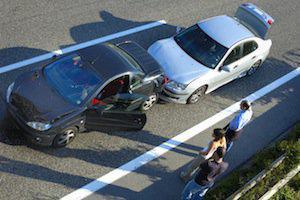 Establishing who is responsible for an accident is not always an easy task. If a person is stopped at a traffic light and is suddenly rear-ended by a drunk driver who also happened to be speeding, then the answer is fairly clear. However, not all situations in the real world are as black and white.
Establishing who is responsible for an accident is not always an easy task. If a person is stopped at a traffic light and is suddenly rear-ended by a drunk driver who also happened to be speeding, then the answer is fairly clear. However, not all situations in the real world are as black and white.
Law school professors like to illustrate the dilemma of establishing fault with an example about a construction worker, John, and a pedestrian, Alex. In the example, John is working beneath the sidewalk and he removes a manhole cover. After he finishes working, John fails to put the cover back over the manhole.
Later, Alex is walking along the sidewalk. He has his eyes glued to his smartphone, and he is not paying attention to anyone or anything around him. Because he is distracted, Alex does not see notice the missing manhole coverand he falls down the hole, injuring himself. While one person in this example may be more at fault than the other, the accident would not have happened without both of their careless behaviors.
Fortunately, the law has developed different ways of handling this problem. In the distant past, almost all states adhered to the doctrine of contributory negligence, which stated that if an injured person was just partially at fault for his or her own injuries, he or she could not receive any compensation. This rule often led to very harsh results.
Consider someone who may have been just one-percent at fault for his or her injuries. Under a pure contributory negligence approach, the one-percent at fault victim could recover nothing at all. As a result, some states, Wisconsin included, felt that a different approach to apportioning fault and resulting damages was necessary and implemented statutes to address this new approach. In Wisconsin, that statute is section 895.045.
Comparative Fault Explained
Comparative fault is a softer version of the pure contributory negligence approach of old. Comparative fault systems still penalize victims for the part that their own carelessness played in an accident without completely cutting off recovery for a partially at fault victim. The comparative fault doctrine instructs jury members to review the evidence surrounding an accident and assign a percentage of responsibility to all of the involved parties. Based on the jury's apportionment of fault, a victim's damages could be reduced accordingly.
Wisconsin follows a modified form of comparative fault known as the “51 percent” rule. In very simplified form, this rule says that if two parties are involved in an accident, the injured party may recover so long as his or her portion of fault is not greater than the other party's portion of fault. Under the “51 percent rule, ” if John is 50 percent at fault and Alex is 50 percent at fault, Alex will be allowed to recover and his damages will be reduced by his portion of fault. Conversely, if John is 49 percent at fault and Alex is 51 percent at fault, Alex can recover nothing. If more than two parties are involved in an accident, the apportionment of fault and an injured party's ability to recover can become more complicated.
An Illustration
As a further example of how the modified comparative fault system works under Wisconsin law, imagine two drivers, Sam and Joe. Sam is driving drunk and Joe is speeding. Joe races his car down a street and enters an intersection. Sam approaches the same intersection, but has a red light. Because Sam is too drunk to notice the red light, he blows through the intersection and collides with Joe. Imagine that as a result of the accident, Joe sustains $10, 000 in damages. The jury would examine the evidence and assign fault to both drivers. Suppose the jury decides that Sam is 70 percent at fault and Joe is 30 percent at fault. Joe would be allowed to recover $7, 000 of the $10, 000 in damages.
Seek the Help of a Skilled Wisconsin Attorney
If you or one of your loved ones was recently injured in a car accident, seek the help of a skilled Green Bay personal injury lawyer or an Appleton personal injury lawyer. Our firm helps victims from four different offices located in Appleton, Green Bay, and Oshkosh.



